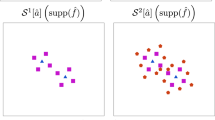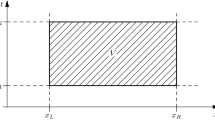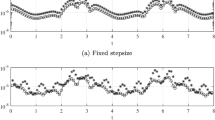Abstract
We investigate efficient algorithms and a practical implementation of an explicit-type high-order timestepping method based on Krylov subspace approximations, for possible application to large-scale engineering problems in electromagnetics. We consider a semi-discrete form of the Maxwell’s equations resulting from a high-order spectral-element discontinuous Galerkin discretization in space whose solution can be expressed analytically by a large matrix exponential of dimension \(\kappa \times \kappa \). We project the matrix exponential into a small Krylov subspace by the Arnoldi process based on the modified Gram–Schmidt algorithm and perform a matrix exponential operation with a much smaller matrix of dimension \(m\times m\) (\(m\ll \kappa \)). For computing the matrix exponential, we obtain eigenvalues of the \(m\times m\) matrix using available library packages and compute an ordinary exponential function for the eigenvalues. The scheme involves mainly matrix-vector multiplications, and its convergence rate is generally \(O(\Delta t^{m-1})\) in time so that it allows taking a larger timestep size as \(m\) increases. We demonstrate CPU time reduction compared with results from the five-stage fourth-order Runge–Kutta method for a certain accuracy. We also demonstrate error behaviors for long-time simulations. Case studies are also presented, showing loss of orthogonality that can be recovered by adding a low-cost reorthogonalization technique.










Similar content being viewed by others
References
Moler, C., Loan, C.V.: Nineteen dubios ways to compute the exponential of a matrix, twenty-five years later. SIAM Rev. 45(1), 3–49 (2003)
Hochbruck, M., Ostermann, A.: Exponential integrators. Acta Numer. 19, 209–286 (2010)
Saad, Y.: Iterative Methods for Sparse Linear Systems. PWS Publishing, Boston (1996)
Saad, Y.: Analysis of some Krylov subspace approximation to the matrix exponential operator. SIAM J. Numer. Anal. 29, 209–228 (1992)
Saad, Y.: Krylov subspace methods on supercomputers. SIAM J. Sci. Stat. Comput. 10(6), 1200–1232 (1989)
Gallopoulos, E., Saad, Y.: Efficient solution of parabolic equations by Krylov approximation methods. SIAM J. Sci. Stat. Comput. 13(5), 1236–1264 (1992)
Novati, P.: A low cost Arnoldi method for large linear initial value problems. Int. J. Comput. Math. 81(7), 835–844 (2004)
Hochbruck, M., Lubich, C., Selhofer, H.: Exponential integrators for large systems of differential equations. SIAM J. Sci. Comput. 19(5), 1552–1574 (1996)
Hochbruck, M., Lubich, C.: On the Krylov subspace approximations to the matrix exponential operator. SIAM J. Numer. Anal. 34(5), 1911–1925 (1997)
Hesthaven, J.S., Warburton, T.: Nodal hihg-order methods on unstructured grids. I: time-domain solution of Maxwell’s equations. J. Comput. Phys. 181(1), 186–221 (2002)
Hesthaven, J.S., Warburton, T.: Nodal Discontinuous Galerkin Methods, Algorithms, Analysis, and Applications, Texts in Applied Mathematics. Springer, Berlin (2008)
Cockburn, B., Li, F., Shu, C.W.: Locally divergence-free discontinuous Galerkin methods. J. Comp. Phys. 194, 588–610 (2004)
Rieben, R., White, D., Rodrigue, R.: High-order symplectic integration methods for finite element solutions to time dependent Maxwell equations. IEEE Trans. Antennas Propag. 56(8), 2190–2195 (2004)
Nédeléc, J.C.: Mixed finite elements in R3. Numer. Math. 159(1), 315–341 (1980)
Forest, E., Ruth, R.D.: Fourth-order sympletic integration. Physica D 43, 105–117 (1990)
Candy, J., Rozmus, W.: A simplectic integration algorithm for separable Hamiltonian functions. J. Comput. Phys. 92, 230–256 (1991)
Golub, G.H., Van Loan, C.F.: Matrix Computations. North Oxford Academic, England (1986)
Strom, T.: On logarithmic norms. SIAM J. Numer. Anal. 12(5), 741–753 (1975)
Parlett, B.N.: The Symmetric Eigenvalue Problem. Prentice Hall, Englewood Clifts, N.J. (1980)
Deville, M.O., Fischer, P.F., Mund, E.H.: High-Order Methods for Incompressible Fluid Flow. Cambridge Monographs on Applied and Computational Mathematics, vol. 9. Cambridge University Press, Cambridge (2002)
Hesthaven, J.S., Gottlieb, S., Gottlieb, D.: Spectral Methods for Time-Dependent Problems. Cambridge Monographs on Applied and Computational Mathematics, vol. 21. Cambridge University Press, Cambridge (2007)
LAPACK, Linear Algebra PACKage, http://www.netlib.org/lapack
Gray, S.K., Kupka, T.: Propagation of light in metallic nanowire arrays: Finite-difference time domain studies of silver cylinders. Phys. Rev. B 68, 045415/1–045415/11 (2003)
Oliva, J.M., Gray, S.K.: Theoretical study of dielectrically coated metallic nanowires. Chem. Phys. Lett. 379, 325–331 (2003)
Zagorodnov, I.: TE/TM field solver for particle beam simulations without numerical Cherenkov radiation. Phys. Rev. Spec. Top. Accel. Beams 8, 042001 (2005)
Gjonaj, E., Lau, T., Schnepp, S., Wolfheimer, F., Weiland, T.: Accurate modeling of charged particle beams in linear accelerators. New J. Phys. 8, 285 (2006)
Min, M.S., Lee, T.W., Fischer, P.F., Gray, S.K.: Fourier spectral simulations and Gegenbauer reconstructions for electromagnetic waves in the presence of a metal nanoparticle. J. Comput. Phys. 213(2), 730–747 (2006)
Min, M.S., Fischer, P.F., Montgomery, J., Gray, S.K.: Large-scale electromagnetic modeling based on high-order methods: nanoscience applications. J. Phys. Conf. Ser. 180, 012016 (2009)
Min, M.S., Fischer, P.F., Chae, Y.C.: Spectral-element discontinuous Galerkin simulations for bunched beam in accelerating structures. In: Proceedings of PAC07, pp. 3432–3434 (2007)
Min, M.S., Lee, T.: A spectral-element discontinuous Galerkin lattice-Boltzmann method for incompressible flows. J. Comput. Phys. 230, 245–259 (2011)
Taflove, A., Hagness, S.C.: Computational Electrodynamics, The Finite Difference Time Domain Method. Artech House, Norwood, MA (2000)
Wolf, D.A.: Essentials of Electromagnetics for Engineering. Cambridge University Press, Cambridge (2000)
Carpenter, M.H., Kennedy, C.: Fourth-order 2\(N\)-storage Runge-Kutta schemes, NASA Report TM 109112, NASA Langley Research Center (1994)
Deville, M.O., Fischer, P.F., Mund, E.H.: High-Order Methods for Incompressible Fluid Flow. Cambridge University Press, Cambridge (2002)
Acknowledgments
This work was supported by the Office of Advanced Scientific Computing Research, Office of Science, U.S. Department of Energy, under Contract DE-AC02-06CH11357.
Author information
Authors and Affiliations
Corresponding author
Rights and permissions
About this article
Cite this article
Min, M., Fischer, P. An Efficient High-Order Time Integration Method for Spectral-Element Discontinuous Galerkin Simulations in Electromagnetics. J Sci Comput 57, 582–603 (2013). https://doi.org/10.1007/s10915-013-9718-8
Received:
Revised:
Accepted:
Published:
Issue Date:
DOI: https://doi.org/10.1007/s10915-013-9718-8




